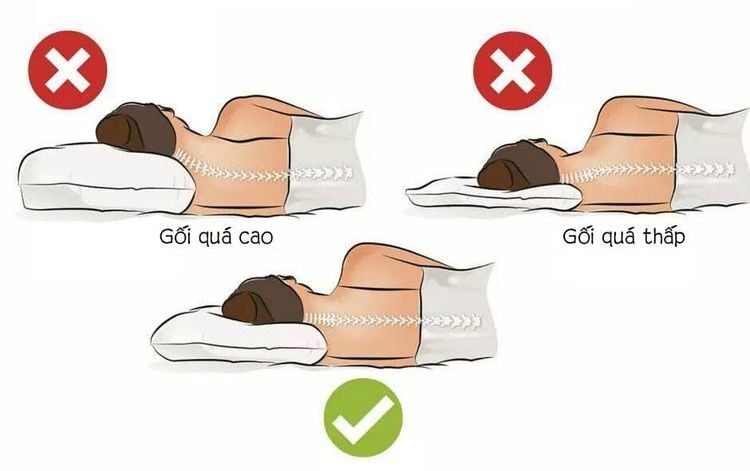This is an automatically translated article.
Posted by Specialist Doctor I Vo Khac Khoi Nguyen - Orthopedic Trauma Doctor - General Surgery Department, Vinmec Central Park International General Hospital.
Humans usually spend about 1/3 of their lives sleeping and resting. In particular, the role of the pillow is very important, it has a relationship with sleep quality, neck and shoulder diseases. Choosing the right pillow helps improve sleep quality as well as help relieve neck and shoulder symptoms when waking up. The following article will guide you on how to choose the right sleeping pillow for your health.
1. How to choose the right pillow?
A statistic shows that about 50% of people surveyed experience health problems related to the use of uncomfortable pillows. Poor sleep quality is often manifested through symptoms such as: Waking up frequently, stiff neck when waking up, shoulder pain. The cause of this problem is the choice of a bad pillow.
Because sleep accounts for a third of a person's life, the optimal pillow must have the role of supporting the neck area to maintain the cervical spine curve and contribute to improving sleep quality. The shape and height of the pillow helps to maintain the physiological curvature of the cervical spine, reducing pressure on the discs, allowing for a better distribution of load between the discs and the cervical vertebrae. Feather pillows are considered the oldest standard pillow used. Active foam pillows are currently popular with users because of their cost and convenience.
With the multitude of styles, materials, and information on the different types of pillows available in the market, it can be confusing to choose the right pillow for us. Sleep survey in healthy people on five pillow types: Polyester, regular foam, contour foam, feather and latex. Using latex, polyester, and foam contour pillows results in a lower frequency of waking neck pain than foam or feather pillows. Polyester pillows, latex contour pillows and latex pillows have a longer service life than foam and feather pillows.
The height of the pillow affects comfort and sleep quality, and is also one of the important factors affecting spinal alignment. However, choosing the correct pillow height can be difficult. People can often choose a pillow based on their immediate feel and comfort, which can be misleading and lead to choosing the wrong pillow size. Consumers often prefer softer pillows because they provide greater comfort, although perception of comfort can change after a while when the body adapts to a new pillow. In fact, a stiff pillow that may seem less comfortable at first is helpful for stabilizing the spine and reducing unwanted spinal deformity. Researchers recommend that the most suitable pillow height is 10 cm. However, this is the recommended height of the pillow you use to lie on your back. When lying on your side, you need a higher pillow to ensure that the cervical spine remains in line with the body.
In terms of medicine, doctors often prioritize using latex pillows in controlling cervical spine pain, improving sleep quality and comfort for patients. Latex pillows work better because they are less prone to subsidence and have a relatively stable height when in use. Feather pillows are less commonly chosen by doctors due to their high softness, although they create a very soft feeling when lying down. However, the choice of pillow material depends on allergies, comorbidities and personal preferences.

2. When should new pillows be changed?
Any item has a certain lifespan and so does a pillow. Estimate how long you should replace a new pillow every one and a half to two years, or even sooner if you're no longer comfortable with it.
We often rarely pay attention to changing pillows because we don't have this habit. More importantly, the pillow does not print the expiration date like other items, and users do not remember how long they have used the current pillow.
A new pillow can be comfortable, but over time, the pillow no longer provides adequate support for the head and neck due to sagging and loss of necessary elasticity. Due to cost and different manufacturers' recommendations on pillow performance, consumers face a difficult decision every time they buy a new pillow. Sometimes changing the pillow depends on the comorbidities you have, not waiting for the pillow to lose quality. For example, a person with low back pain should sleep on their side while you are a person who has a habit of lying on your back before, you should change a new pillow with a more suitable height for your shoulders and neck.

3. There is no perfect pillow!
Low sleep quality that cannot be attributed entirely to the pillow. Factors that significantly limit sleep quality are underlying medical conditions, history of cervical spine injury, sleeping position, nocturnal bruxism, sleep apnea... All issues These can all contribute to low sleep quality. Before "blaming" low quality of sleep due to the pillow, you should pay attention to the internal abnormalities of the body to adjust in time before we are constantly looking for an ideal pillow. The pillow is ultimately an external cause and should be considered the ultimate cause after ruling out other issues that may be affecting your sleep.
In short, a pillow is not simply an ordinary household item. It must be considered a personal item, that is, it must be personalized to suit each user. Although pillows are mass-produced, you need to choose and use them to suit yourself. There is no manufacturer that makes the most ideal pillow or the best quality, but only the user knows how to choose for himself the most ideal, most suitable pillow for himself.
Please dial HOTLINE for more information or register for an appointment HERE. Download MyVinmec app to make appointments faster and to manage your bookings easily.














